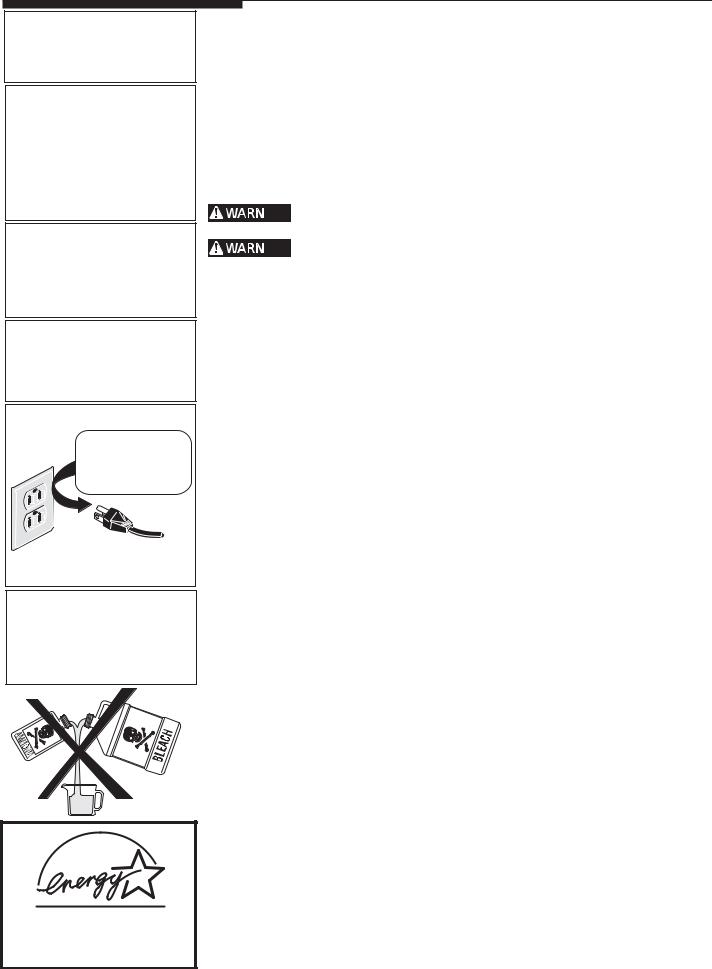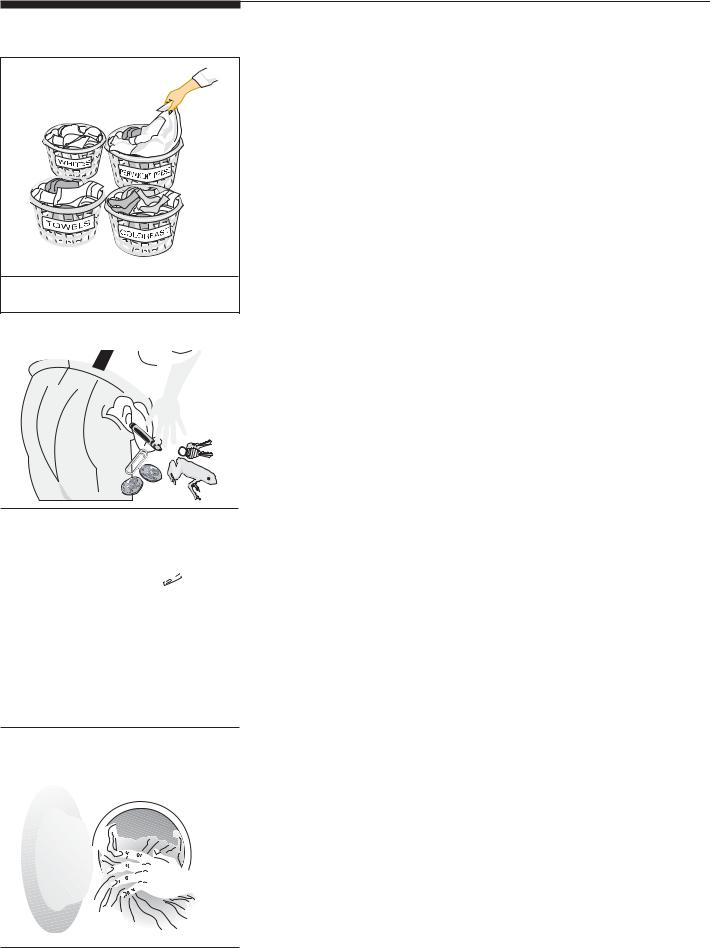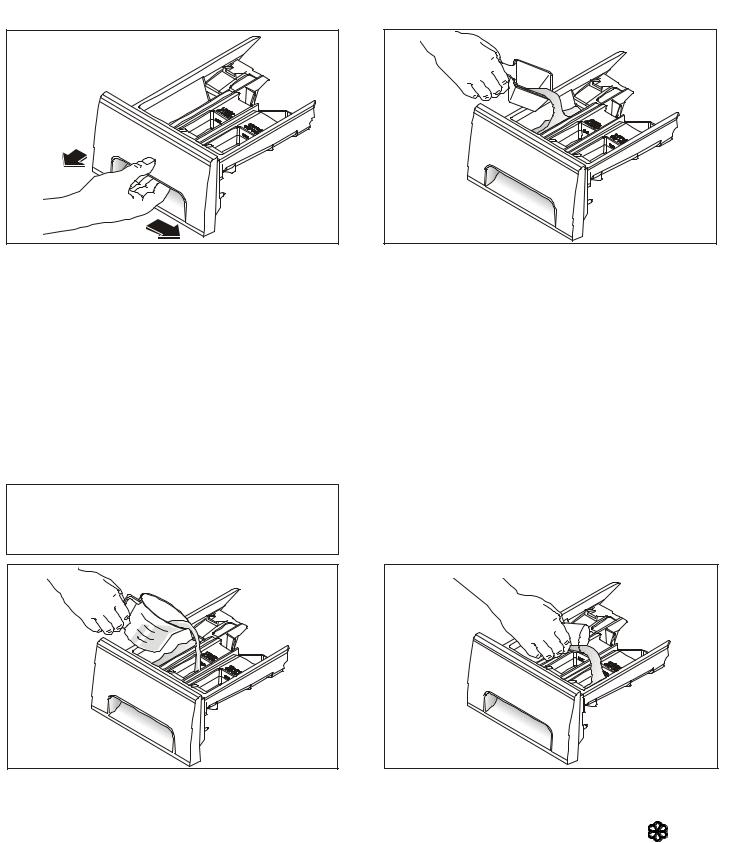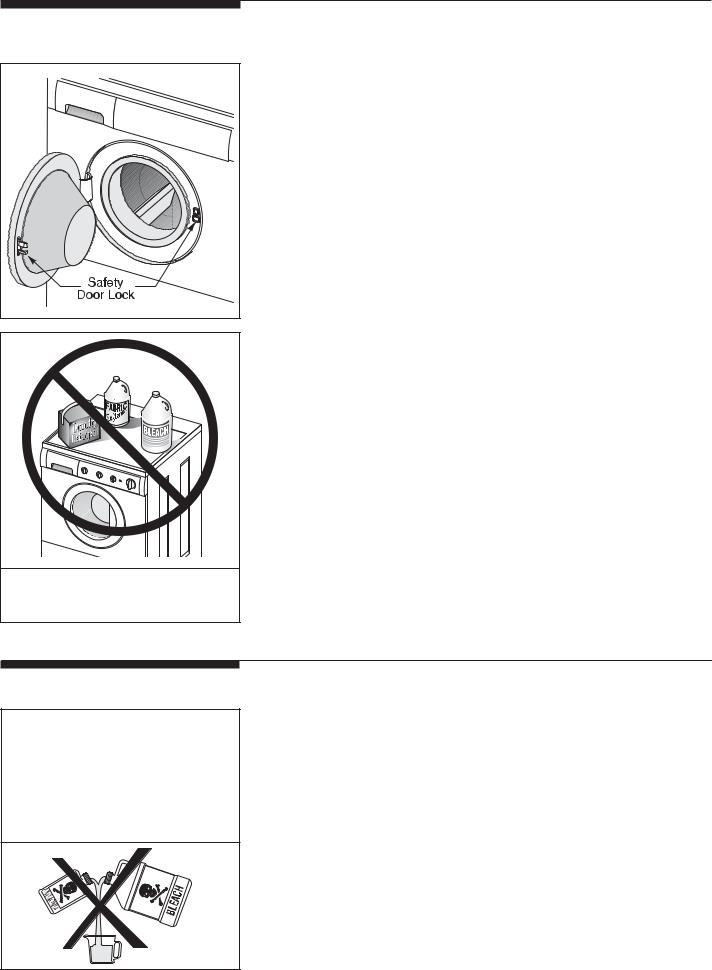Frigidaire LTF530DS1 Owner’s Manual

TUMBLE ACTION WASHER
Use & Care Guide
LAVADORA CON TAMBOREACCIÓN
Manual de Uso & Mantenimiento
Table of Contents |
|
IMPORTANT SAFETY INSTRUCTIONS ................................ |
2 |
Washing Procedures ............................................. |
3-5 |
Stain Removal ...................................................... |
5-6 |
Common Washing Problems ..................................... |
7 |
Care and Cleaning ........................................................... |
8-9 |
AvoidServiceChecklist................................................... |
9-10 |
Español............................................................................... |
11-20 |
Instrucciones importantes para la seguridad ................ |
11-12 |
Procedimientos para el lavado ..................................... |
13-15 |
Removerlasmanchas.................................................... |
15-16 |
Problemas de lavado communes ..................................... |
17 |
Cuidadoylimpieza....................................................... |
18-19 |
Evitarllamadasdeservicio............................................. |
19-20 |
ENGLISH
|
|
|
|
|
|
|
|
|
|
Product Registration |
Read and Save These Instructions |
|
|||||
|
Thank you for choosing this |
Record Your Model and Serial Numbers |
|
|||||
|
washer. This owner's guide will |
|
||||||
|
The model and serial numbers of your washer are found on the washer |
|
||||||
|
explain proper operation and care. |
|
||||||
|
serial plate located at the top, inside of the door opening. Record and |
|
||||||
|
Register Your Product |
|
||||||
|
retain these numbers. |
|
||||||
|
The self-addressed PRODUCT |
|
||||||
|
|
|
|
|
|
|
|
|
|
REGISTRATION CARD should be |
Anote su Número de Modelo y de Serie |
|
|||||
|
filled in completely, signed and |
|
||||||
|
returned. |
Anote a continuación el número de modelo y de serie que se encuentran |
|
|||||
|
Registro del Producto |
en la placa de serie situada en el interior de la puerta de la lavadora. |
|
|||||
|
Conserve estos números para referencia futura. |
|
||||||
|
Leagradecemosquehayaseleccio- |
|
||||||
|
|
|
|
|
|
|
|
|
|
nado esta lavadora. En este manual |
Model Number: |
|
|||||
|
del usuario encontrará las intrucciones |
|
||||||
|
apropiadas para su funcionamiento y |
Número de Modelo: |
|
|
|
|||
|
Serial Number: |
|
||||||
|
cuidado. |
|
||||||
|
Registre su Producto |
Número de Serie: |
|
|
|
|
|
|
|
Purchase Date: |
|
||||||
|
La TARJETA DE REGISTRO DEL |
|
||||||
|
PRODUCTO ya dirigida debe ser |
Fecha de compra: |
|
|
|
|
|
|
|
|
|||||||
|
llenada, firmada y enviada. |
|
|
|
|
|
|
|
|
|
|
|
|
|
|
|
|
|
|
|
|
|
|
|
|
|
1 |
P/N 134567200 (0506) |

FOR YOUR SAFETY
Do not store or use gasoline or other flammable vapors or liquids in the vicinity of this or any other appliance.
This Owner's Guide provides general operating instructions for your washer. It also contains information about features for several other models. Your washer may not have every feature included here.
Use the washer only as instructed in this Owner's Guide and the Operating Instructions card included with your washer.
Note: The instructions appearing in this Owner's Guide are not meant to cover every possible condition and situation that may occur. Common sense and caution must be practiced when installing, operating and maintaining any appliance.

 Avoid fire hazard or electrical shock. Do not use an adaptor plug or extension cord or remove grounding prong from electrical power cord. Failure to follow this warning can cause serious injury, fire or death.
Avoid fire hazard or electrical shock. Do not use an adaptor plug or extension cord or remove grounding prong from electrical power cord. Failure to follow this warning can cause serious injury, fire or death.
Grounding type wall receptacle
Do not under any circumstances, cut, remove, or bypass the grounding prong from this plug.
Power supply cord with 3-prong grounding plug
CORRECT Use this way ONLY




 Do not use or mix liquid chlorine bleach with other household chemicals such as toilet cleaners, rust removers, acid or products containing ammonia. These mixtures can produce dangerous fumes which can cause serious injury or death.
Do not use or mix liquid chlorine bleach with other household chemicals such as toilet cleaners, rust removers, acid or products containing ammonia. These mixtures can produce dangerous fumes which can cause serious injury or death.
As an ENERGY STAR® Partner,
it has determined that this product meets the ENERGY STAR® guidelines for energy efficiency.
Important Safety Instructions |
SAVE THESE INSTRUCTIONS |
Read all instructions before using this washer.






 To reduce the risk of fire, electrical shock, or injury to persons when using this washer, comply with the basic warnings listed below.
To reduce the risk of fire, electrical shock, or injury to persons when using this washer, comply with the basic warnings listed below.
 Failure to comply with these warnings could result in serious personal injuries.
Failure to comply with these warnings could result in serious personal injuries.
Prevent Fire




 Do not wash items that have been previously cleaned in, soaked in, or spotted with gasoline,
Do not wash items that have been previously cleaned in, soaked in, or spotted with gasoline,
cleaning solvents, kerosene, cooking oils, waxes, etc. Do not store these items on or near the washer. These substances give off vapors or chemical reactions that could ignite or explode.




 Do not put oily or greasy rags or clothing on top of the washer. These substances give off
Do not put oily or greasy rags or clothing on top of the washer. These substances give off
vapors that could ignite the materials.

 Do not add gasoline, cleaning solvents, or other flammable or explosive substances to the
Do not add gasoline, cleaning solvents, or other flammable or explosive substances to the
wash water. These substances give off vapors that could ignite or explode.

 Under certain conditions, hydrogen gas may be produced in a hot water system that has
Under certain conditions, hydrogen gas may be produced in a hot water system that has
not been used for 2 weeks or more. HYDROGEN GAS IS EXPLOSIVE. If the hot water system has not been used for such a period, before using the washer, turn on all hot water faucets and let the water flow from each for several minutes. This will release any accumulated hydrogen gas. Hydrogen gas is flammable; do not smoke or use an open flame during this time.
 Failure to comply with these warnings could result in fire, explosion, serious bodily injury and/or damage to the rubber or plastic parts of the washer.
Failure to comply with these warnings could result in fire, explosion, serious bodily injury and/or damage to the rubber or plastic parts of the washer.
Protect Children




 Do not allow children to play on or in the washer. Close supervision of children is necessary when the washer is used near children. As children grow, teach them the proper, safe use of all appliances.
Do not allow children to play on or in the washer. Close supervision of children is necessary when the washer is used near children. As children grow, teach them the proper, safe use of all appliances.




 Destroy the carton, plastic bag and other packing materials after the washer is unpacked. Children might use them for play. Cartons covered with rugs, bedspreads or plastic sheets can become airtight chambers.
Destroy the carton, plastic bag and other packing materials after the washer is unpacked. Children might use them for play. Cartons covered with rugs, bedspreads or plastic sheets can become airtight chambers.




 Keep laundry products out of children's reach. To prevent personal injury, observe all
Keep laundry products out of children's reach. To prevent personal injury, observe all
warnings on product labels.




 Before the washer is removed from service or discarded, remove the washer door to prevent accidental entrapment.
Before the washer is removed from service or discarded, remove the washer door to prevent accidental entrapment.
 Failure to comply with these warnings could result in serious personal injuries.
Failure to comply with these warnings could result in serious personal injuries.
Prevent Injury




 To prevent shock hazard and assure stability during operation, the washer must be installed and electrically grounded by a qualified service person in accordance with local codes. Installation instructions are packed in the washer for installer's reference. Refer to INSTALLATION INSTRUCTIONS for detailed grounding procedures. If the washer is moved to a new location, have it checked and reinstalled by a qualified service person.
To prevent shock hazard and assure stability during operation, the washer must be installed and electrically grounded by a qualified service person in accordance with local codes. Installation instructions are packed in the washer for installer's reference. Refer to INSTALLATION INSTRUCTIONS for detailed grounding procedures. If the washer is moved to a new location, have it checked and reinstalled by a qualified service person.




 To prevent personal injury or damage to the washer, the electrical power cord of the
To prevent personal injury or damage to the washer, the electrical power cord of the
washer must be plugged into a properly grounded and polarized 3-prong outlet. The third grounding prong must never be removed. Never ground the washer to a gas pipe. Do not use an extension cord or an adaptor plug.




 Follow package directions when using laundry products. Incorrect usage can produce poisonous gas--resulting in serious injury or death.
Follow package directions when using laundry products. Incorrect usage can produce poisonous gas--resulting in serious injury or death.
•Do not combine laundry products for use in 1 load unless specified on the label.
•Do not mix chlorine bleach with ammonia or acids such as vinegar.




 To prevent serious personal injury and damage to the washer:
To prevent serious personal injury and damage to the washer:
•All repairs and servicing must be performed by an authorized servicer unless specifically recommended in this Owner's Guide. Use only authorized factory parts.
•Do not tamper with controls.
•Do not install or store the washer where it will be exposed to the weather.
•Do not install on carpet. Install washer on a solid floor. It may be necessary to reinforce the floor to prevent vibration or movement.




 To reduce the risk of electric shock, disconnect this appliance from the power supply before attempting any user maintenance. Turning the controls to the OFF position does not disconnect this appliance from the power supply.
To reduce the risk of electric shock, disconnect this appliance from the power supply before attempting any user maintenance. Turning the controls to the OFF position does not disconnect this appliance from the power supply.




 To prevent injury, do not reach into the washer while parts are moving. Before loading,
To prevent injury, do not reach into the washer while parts are moving. Before loading,
unloading or adding items, push in the cycle selector knob and allow the drum to coast to a complete stop before reaching inside.
 Failure to comply with these warnings could result in serious personal injuries.
Failure to comply with these warnings could result in serious personal injuries.
 This washer is equipped with an electrical overload protector. The motor will stop if it becomes overheated. The washer will automatically restart after a cool down period of up to 30 minutes, if the washer has not been manually turned off during this time.
This washer is equipped with an electrical overload protector. The motor will stop if it becomes overheated. The washer will automatically restart after a cool down period of up to 30 minutes, if the washer has not been manually turned off during this time.
2 |
Printed in U.S.A. |

Washing Procedures
Sort laundry into loads that can be washed together.
Empty pockets.
Place delicate items in a mesh bag.
•Follow the guidelines below for preparing the wash load.
•Read the Operating Instructions card for operating your specific model.
•Always read and follow fabric care and laundry product labels.

 To reduce the risk of fire, electrical shock, or injury to persons, read Important Safety Instructions, page 2, before operating this washer.
To reduce the risk of fire, electrical shock, or injury to persons, read Important Safety Instructions, page 2, before operating this washer.
1. Sort laundry into loads that can be washed together.
Sort items by recommended water temperatures and wash time.
•Separate white, light, and colorfast items from dark and noncolorfast items.
•Separate items which shed lint from items which attract lint. Permanent press, synthetic, knit and corduroy items will pick up lint from towels, rugs and chenille bedspreads.
•Separate heavily soiled items from lightly soiled items.
•Separate lacy, sheer and loosely knit items from sturdy items.
•Do not machine wash items containing fiberglass. Small particles of fiberglass left in the drum may stick to fabrics in other loads and cause skin irritation.
2.Prepare items for washing.
•Empty pockets.
•Brush off lint and dirt. Shake out rugs and beach towels.
•Close zippers, fasten hooks, tie strings and sashes, and remove nonwashable trims and ornaments.
•Remove pins, decorative buttons, belt buckles, and other objects which could be damaged. This also helps protect other items in the wash load.
•Mend rips and tears to prevent further damage during washing.
•Place delicate items such as bras, shoulder pads, hosiery, and belts in a mesh bag to prevent tangling during the wash cycle.
•Turn knit items inside out to prevent pilling.
3.Pretreat stains and heavy soil.
See Stain Removal, pages 5-6, for details.
4.Add laundry load to washer.
•Combine large and small items in a load. Load large items first. Large items should not be more than half the total wash load.
•Washing single items such as a sweater, towel or jeans may cause an out- of-balance load. Add 1 or 2 similar items to help balance the load.
•Single heavy items such as a bedspread can be washed separately.
•The washer can be fully loaded, but the items should not be tightly packed. The door should close easily.
Add laundry load to washer.
3

5. Add detergent, bleach and fabric softener to automatic dispenser following these steps:
A.OPENING AND CLOSING THE DISPENSER DRAWER
•Slowly open the dispenser drawer by first sliding the safety latch to the right, then pulling the drawer out until it stops.
•Afteraddinglaundryproducts,slowlyclosethedispenser drawer. Closing the drawer too quickly could result in early dispensing of the bleach and fabric softener.
•Dispenser drawer should be completely closed for powdered detergent, bleach and fabric softener to dispense.
•Laundryproductsusedwithpowderorliquiddetergent, such as color-safe bleach, water conditioner, detergent booster, and enzyme products should be added to the empty tub before loading.
Note: From time to time you may see water in the bleach and fabric softener compartments. This is a result of the siphoning action and is part of the normal operation of the washer.
B.DETERGENT
•Addmeasureddetergenttothedetergentcompartment of the dispenser drawer.
•Detergentisflushedfromthedispenseratthebeginning of the cycle. Either powdered or liquid detergent can be used. Note: Liquid detergent will drain into the washer drum as it is added.
•Lowsudsingdetergentisrecommendedforthiswasher. Use the manufacturer's recommended amount.
•If low sudsing detergent is not available, a reduced amount of regular detergent may be used. Because reducingtheamountofdetergentmayreducecleaning, it is important to pretreat stains, sort carefully by color and soil level, and avoid overloading.
•Detergent usage may need to be adjusted for water temperature, water hardness, size and soil level of the load.
•For best results, avoid oversudsing.
C.LIQUID BLEACH
•If desired, measure out the recommended amount of liquid chlorine bleach (not to exceed 1/3 cup (80 mL))
and pour it into the center compartment labeled "Liquid Bleach" and marked with this symbol  .
.
•Do not exceed the maximum fill line. Overfilling can cause early dispensing of the bleach which could result in damaged clothes.
•Do not pour undiluted liquid chlorine bleach directly onto the load or into the drum. Fabric damage can occur.
•Do not use powdered bleach in the dispenser.
D.FABRIC SOFTENER
•If desired, pour the recommended amount of fabric softenerintothecompartmentlabeled"FabricSoftener"
and marked with this symbol |
. |
•Dilute concentrated softeners with warm water to the Fill Line.
•Do not exceed the maximum fill line. Overfilling can cause early dispensing of the fabric softener which could result in stained clothes.
•Do not pour fabric softener directly on the wash load.
•Use of a fabric softener dispensing ball is not recommended in tumble action washers.
4

Washing Procedures
(continued) |
6.Set cycle selector knob and washer controls according to type, size, and soil level of each load.
(See Operating Instructions card for your specific model controls.)
7. Start the washer.
Close the washer door and pull out the cycle selector knob. For your safety, the door will automatically lock during the entire wash cycle. The Door Lock indicator light will remain lit until the cycle ends.
•Washer will fill and tumble.
•To stop the washer, push in the cycle selector knob.
•To open the door during tumbling, push in the cycle selector knob. Wait for the water to run off of the door.
•To change a cycle, push in the cycle selector knob and turn it clockwise to the desired setting. Pull out the knob to restart the washer.
•To open the door during a spin cycle, push in the cycle selector knob. The Door Lock indicator light will turn off. Wait 1-2 minutes for the lock to release. The
door can then be opened. Do not force open the locked door.
Do not store or place laundry products on top of washer at any time. They can damage the finish or controls.
8. Remove items when the cycle is completed.
Place washed items in automatic dryer, line dry, or dry flat as directed by fabric care label. Excess wrinkling, color transfer or odors may develop in items left in the washer after the cycle has ended.
9.General Precautions
•Dispenser drawer should be completely closed during operation.
•Do not slam the washer door closed or try to force the door open when locked (Door Lock light ON). This could result in damage to the washer.
•DO NOT leave the washer door open. An open door could entice children to hang on the door or crawl inside the washer.
•To avoid damaging the washer and personal injury, DO NOT hang on or lean against the washer door.
•Do not place detergent, bleach or fabric softener containers on top of the washer. They can damage the finish or controls.
Stain Removal

 Do not use or mix liquid chlorine bleach with other household chemicals such as toilet cleaners, rust removers, acid or productscontainingammonia.These mixtures can produce dangerous fumes which can cause serious injury or death.
Do not use or mix liquid chlorine bleach with other household chemicals such as toilet cleaners, rust removers, acid or productscontainingammonia.These mixtures can produce dangerous fumes which can cause serious injury or death.
Safe Stain Removal Procedures




 To reduce the risk of fire or serious injury to persons or property, comply with the basic warnings listed below:
To reduce the risk of fire or serious injury to persons or property, comply with the basic warnings listed below:
•Read and comply with all instructions on stain removal products.
•Keep stain removal products in their original labeled containers and out of children's reach.
•Thoroughly wash any utensil used.
•Do not combine stain removal products, especially ammonia and chlorine bleach. Dangerous fumes may result.
•Never wash items which have been previously cleaned in, washed in, soaked in or spotted with gasoline, dry cleaning solvents or other flammable or explosive substances because they give off vapors that could ignite or explode.
•Never use highly flammable solvents, such as gasoline, inside the home. Vapors can explode on contact with flames or sparks.
5

For successful stain removal:
•Remove stains promptly.
• Determine the kind of stain, then follow the recommended treatment in the stain removal chart below.
•To pretreat stains, use a prewash product, liquid detergent, or a paste made from granular detergent and water.
•Use cold water on unknown stains because hot water can set stains.
•Check care label instructions for treatments to avoid on specific fabrics.
•Check for colorfastness by testing stain remover on an inside seam.
•Rinse and wash items after stain removal.
Follow fabric care label instructions.
|
Stain Removal |
STAIN |
TREATMENT |
Adhesive tape, chewing gum, |
Apply ice. Scrape off excess. Place stain face down on paper towels. Saturate with prewash stain remover or |
rubber cement |
nonflammable dry cleaning fluid. |
|
|
Baby formula, dairy products, |
Use product containing enzymes to pretreat or soak stains. Soak for 30 minutes or more. Wash. |
egg |
|
|
|
Beverages (coffee, tea, soda, |
Pretreat stain. Wash using cold water and bleach safe for fabric. |
juice, alcoholic beverages) |
|
|
|
Blood |
Rinse with cold water. Rub with bar soap. Or, pretreat or soak with product containing enzymes. Wash using |
|
bleach safe for fabric. |
|
|
Candle wax, crayon |
Scrape off surface wax. Place stain face down between paper towels. Press with warm iron until wax is |
|
absorbed. Replace paper towels frequently. Treat remaining stain with prewash stain remover or nonflammable |
|
dry cleaning fluid. Hand wash to remove solvent. Wash using bleach safe for fabric. |
|
|
Chocolate |
Pretreat or soak in warm water using product containing enzymes. Wash using bleach safe for fabric. |
|
|
Collar or cuff soil, cosmetics |
Pretreat with prewash stain remover or rub with bar soap. |
|
|
Dye transfer on white fabric |
Use packaged color remover. Wash using bleach safe for fabric. |
|
|
Grass |
Pretreat or soak in warm water using product containing enzymes. Wash using bleach safe for fabric. |
|
|
Grease, oil, tar (butter, fats, |
Scrape residue from fabric. Pretreat. Wash using hottest water safe for fabric. For heavy stains and tar, apply |
salad dressing, cooking oils, |
nonflammable dry cleaning fluid to back of stain. Replace towels under stain frequently. Rinse thoroughly. Wash |
car grease, motor oils) |
using hottest water safe for fabric. |
|
|
Ink |
Some inks may be impossible to remove. Washing may set some inks. Use prewash stain remover, denatured |
|
alcohol or nonflammable dry cleaning fluid. |
|
|
Mildew, scorch |
Wash with chlorine bleach if safe for fabric. Or, soak in oxygen bleach and hot water before washing. Badly |
|
mildewed fabrics may be permanently damaged. |
|
|
Mud |
Brush off dry mud. Pretreat or soak with product containing enzymes. |
|
|
Mustard, tomato |
Pretreat with prewash stain remover. Wash using bleach safe for fabric. |
|
|
Nail polish |
May be impossible to remove. Place stain face down on paper towels. Apply nail polish remover to back of stain. |
|
Repeat, replacing paper towels frequently. Do not use on acetate fabrics. |
|
|
Paint, varnish |
WATER BASED: Rinse fabric in cool water while stain is wet. Wash. Once paint is dry, it cannot be removed. OIL |
|
BASED AND VARNISH: Use solvent recommended on can label. Rinse thoroughly before washing. |
|
|
Perspiration |
Use prewash stain remover or rub with bar soap. Rinse. Wash using nonchlorine bleach in hottest water safe for |
|
fabric. |
|
|
Rust, brown or yellow |
For spots, use rust remover safe for fabric. For discoloration of an entire load, use phosphate detergent and |
discoloration |
nonchlorine bleach. Do not use chlorine bleach because it may intensify discoloration. |
|
|
Shoe polish |
LIQUID: Pretreat with a paste of granular detergent and water. PASTE: Scrape residue from fabric. Pretreat |
|
with prewash stain remover or nonflammable dry cleaning fluid. Rinse. Rub detergent into dampened area. |
|
Wash using bleach safe for fabric. |
|
|
Urine, vomit, mucus, feces |
Pretreat or soak in product containing enzymes. Wash using bleach safe for fabric. |
|
|
6
